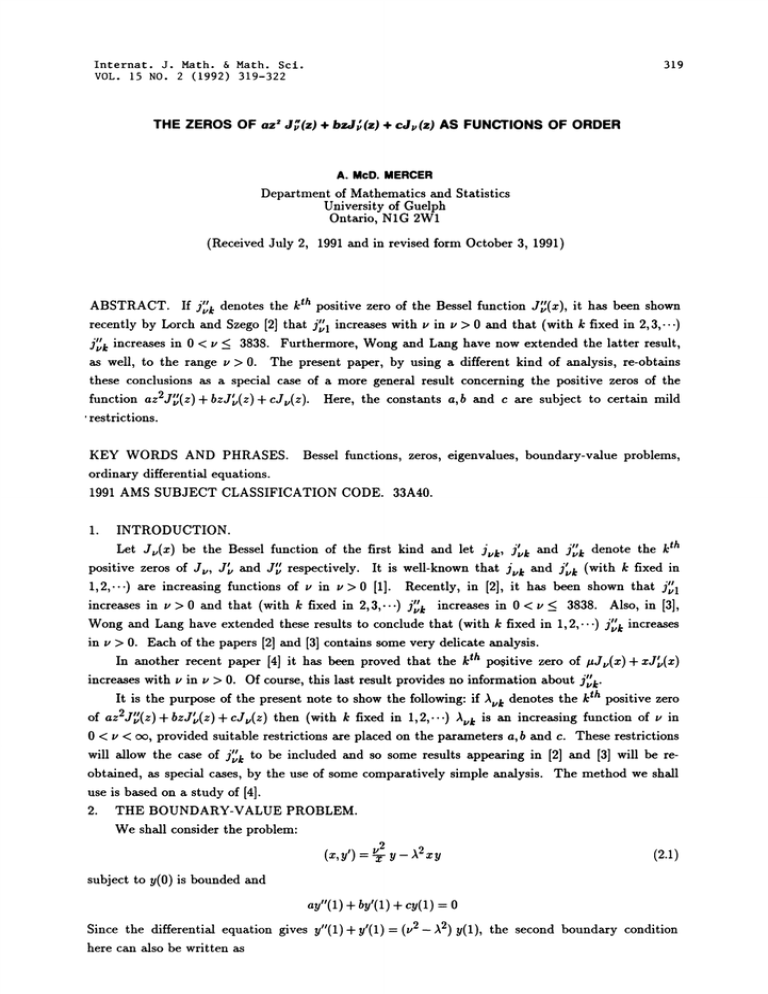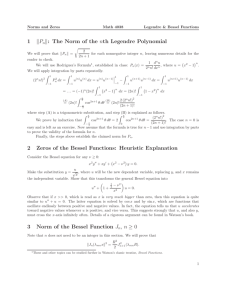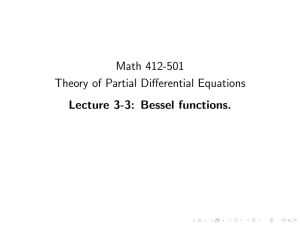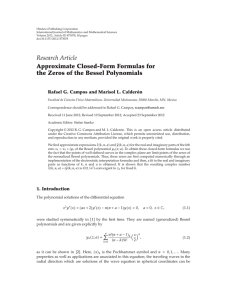Document 10442984
advertisement

Internat. J. Math. & Math. Sci.
VOL. 15 NO. 2 (1992) 319-322
THE ZEROS OF
az
319
J(z)+ bzJ;(z)+ cJv(z) AS FUNCTIONS OF ORDER
Department
A. McD. MERCER
of Mathematics and Statistics
University of Guelph
Ontario, N1G 2Wl
(Received July 2, 1991 and in revised form October 3, 1991)
ABSTRACT If .lvk denotes the k th positive zero of the Bessel function J(x), it has been shown
recently by Lorch and Szego [2] that Jl increases with v in v ) 0 and that (with k fixed in 2,3,...)
j" increases in 0 (v < 3838. Furthermore, Wong and Lang have now extended the latter result,
s well, to the range v )0. The present paper, by using a different kind of anMysis, re-obtains
these conclusions &s a speciM case of a more general result concerning the positive zeros of the
function az 2 Jr(z)+bzJ(z)+ cJv(z). Here, the constants a,b md e are subject to certain mild
restrictions.
KEY WORDS AND PHRASES. Bessel functions, zeros, eigenvalues, boundary-value problems,
ordinary differential equations.
1991 AMS SUBJECT CLASSIFICATION CODE. 33A40.
INTRODUCTION.
Let Jr(x) be the Bessel function of the first kind and let Jvk, J’vk and J"vk denote the k th
positive zeros of Jr, J, and J respectively. It is well-known that Jvk and 3vk (with k fixed in
1.
increasing functions of v in v > 0 [11. Recently, in [2], it has been shown that Jl
increases in v > 0 and that (with k fixed in 2,3,...) 3v/
"’ increases in 0 < v < 3838. Also, in [3],
Wong and Lang have extended these results to conclude that (with k fixed in 1,2,-..) Jk increases
in v > 0. Each of the papers [2] and [3] contains some very delicate analysis.
In another recent paper [4] it has been proved that the k th positive zero of pJv(x)+ xJ’v(z)
increases with v in v > 0. Of course, this last result provides no information about j"vk"
It is the purpose of the present note to show the following: if Ark denotes the k th positive zero
of az2J(z)+ bzJ’v(z)+ cJt,(z) then (with k fixed in 1,2,...)
is an increasing function of v in
0 < v < oo, provided suitable restrictions are placed on the parameters a, b and c. These restrictions
will allow the case of v to be included and so some results appearing in [2] and [3] will be reobtained, as special cases, by the use of some comparatively simple analysis. The method we shall
use is based on a study of [4].
1,2,-..)
are
Av:
2.
THE BOUNDARY-VALUE PROBLEM.
We shall consider the problem:
(,V)
v2
subject to y(0) is bounded and
-
A2
ay"(1) + by’(1) + cy(1)
Since the differential equation gives y"(1) + y’(1)
here can also be written as
(2.)
0
(v 2 A 2) y(1), the second boundary condition
A. McD. MERCER
320
[a(u2-,2)+c]y(1)+qy’(1)=O
(2.2)
(where q=_b-a)
There is clearly no loss of generality if we take c >_ 0. Also, since the case q 0 is essentially the
case of studying the zeros Jr,k, which is classical, we shall henceforth assume that q # 0. In the
analysis to follow, certain restrictions will be. placed on these parameters (except in 5(a) and
Theorem 2) so now, at the outset, we state these once and for all and refer to them as "Condition
’. They are
(c=0andq#0)
It is
(c>0andq>0)
or
(5)
a trivial matter to solve the above boundary-value problem and we see that its solution is
y(z)
AJu(,x)
where A is an arbitrary constant and A is a zero of
az
Ju(z) + bzJ’t,(z) + cJu(z) =- [a(t,2
z
2) + c]Ju(z) + qzJ’t,(z)
Clearly, this function possesses an infinity of real positive zeros which we enumerate as
(k
3.
1,2,...).
AN EXPRESSION FOR
We shall write t,k
A r,k"
^
A2uk and, whenever there is no risk of confusion, simply write
^
The eigenfunction corresponding to A will be Yt, or simply y.
t,k
A and
k
Let A and y be an eigen-solution of (2.1). Multiply (2.1) by y and integrate
over
(0,1). We
get
y’(1)y(1)-
f
To deal with the first term here, multiply (2.2) and y(1) and
2
1_
+ y2(1). After simplification we get
q
[a(t, ^ c]
use this to
replace the first term by
x[y’(x)dx 4" y2(1)
(3.1)
where
1 y2(x)dx 4-
y2(1
(3.2)
Q=Io xy2(x)dx + y2(1)
(3.3)
p
0
and
AN EXPRESSION FOR OAuk
Or,
We follow the technique of [4]. But here the eigenvalue appears in the boundary condition as
well as in the differential equation. For a fixed k we let the variable v change to v + e. Again we
shall avoid the use of suffices by letting the ’before and after’ values of Avk and yv(x) be denoted
by A and F and by y and v respectively.
From (2.1) we get
(xy’)’=y- A xy
and
(xv’)’ (. +z )2 v-rzv
Multiplying the former of these by v, the latter by y, subtracting and integrating over (0,1), we get
It,2- (v + e)2] lyvdx-(A -F)
[a(tfi A )4- c] y(1)4" q y’(1) 0
q v’(1) 0
[a((, + d- r)+
y’(1)v(1) v’(1)y(1)=
Now from (2.2)
and
we also have
I0
I
xyv dx
0
(4.1)
ZEROS OF
We now
az2J"(z) +
use these to remove
y’(1) and v’(1) from the first term in (4.1) and, after simplifying,
_
get
Now
321
bzJ’(z) + cJ (z) AS FUNCTIONS OF ORDER
0
2_(+)2
n-r
d
2u
-e
so dividing this lt equation by -e and letting e
we
xyv dx
0n
0 and simplifying, we get
0A
2up=
(4.2)
where P d Q e given by (3.2) d (3.3) above.
Before continuing, a word concerning the limiting processes which have taken place here, in
psing from (4.1) to (4.2), sms to be in order. If the zero Ag (for a fixed k) is known to be
continuous function of g, it will follow that so is J(Agtx), for each x in (0,1). The inequMity
Mong with Lebesgue’s theorem of dominated convergence will then allow us to conclude that
I vdx(4.1) d
(+e),
f& exple. The oher terms in
1
is indd
can be deal wih similly. he fac that
continuous function of c be established by anysis ogous o tha in [1] (p. 246). It is
interesting to note that, in the present ce, it is merely the continuity d not the differentiability
wigh respec o which is nded at he ougset.
of
5. CONCLUSIONS.
or ee of reference, let us write ou equations (a.1) d (4.2) again. They are
I
d
0A
2p=
in wch A
note that
A k, y
O
(.2)
y and P d Q e given by equations (3.2) d (3.3). In pticul we
his iequMiy, ong with (4.2), shows hag is never ero. Pot a given d eigen-solution I,
it wi, i generM, not be know whether
is positive or negative. So let us exine he
consequences of eech possibility.
(a) he ce of 0 > 0.
Since is homogenous in
we e ehse he re bigry consan A of ghe solution go
,
OA
=2P=21+
(
d since the integr here is positive we find hat
A -2) > 0 for such
eigen-solution.
(b) The ce of Q < 0.
Let us now require that ’Condition applies to the peers. We eliminate P fom
d (4.2) which gives
OA
dx
’
By ’Condition
’
{
x[y’(x)
(3.1)
+ y2(1)}
the right hd side is positive. And since Q is negative, it must be the ce that
0h 2A >0
0
322
so that
-
Since
A. McD. MERCER
> 0 for such
(A21
/shall usually
an eigen-solution.
not know which of these cases we are in, let us impose ’Condition
generally. On replacing A by A 2 in the above conclusions we then obtain the following result:
b- a) then (with k fixed
THEOREM I. If ’Condition 9’ applies to the parameters c and q
,, + bzJ(z) + CJu(z is an increasing flmction of , in
1,2,.-) the positive zero Auk of az 2Ju(z)
, > 0. In particular, on taking a 1, b c 0, we find that j"uk increases with , in , > 0.
There is one set of circumstances in which we can be sure that Q is positive for all eigensolutions; that is when E 0 (see equation (3.3)). In this case there is no need to invoke ’Condition
in
’. The result is:
THEOREM 2. Subject only to the restriction that
a/(b- a)) E 0, A2/- ,2 is an increasing
th
,
/for
function of
> 0. Here, again, Auk denotes the k positive zero of az2J’(z) + bzJ’(z) + cJu(z
and k is fixed in the range 1,2,....
We shall conclude with the following note. In the case in which a
q -1), the result (4.2) specializes to
1, and b
0
(Here and in what follows
( ))) ot
we
c
0(and
so
(.)
shall, for brevity, write j" to mean j). Now from [5] (p. 135, eq.
I
and so, using this and treating the numerator in an obvious way, (5.2) becomes
Now in [2] other expression for
w given nely,
(j")
so, comparing these, we conclude that
j2(j,,) + Ju- l(J") Ju + l(J")
Now it was also proved in [2] that if , > 0 (k
f’Ju(J") J,’(J")
2,3,...) or if 0 < v _< 1 (k 1) then the right hand
side here is negative. Then, so too, must be the left hand side in these cases.
In conclusion, wish to acknowledge the helpful suggestions of the referee.
1.
2.
3.
4.
5.
REFERENCES
OLVER, F.W.J., Asymptotics and special functions, Academic Press, New York and London,
(1974).
LORCH L. and SZEGO, P., On the points of inflection of Bessel functions of positive order. I.
Can. ,/our. Math. Vol. XLIV, No. 5, 1990, pp. 933-948.
WONG, R. and LANG, T., On the points of inflection of Bessel functions of positive order. If.
Can. ,/our. Math. Vol. XLIV, No. 3, 1991, pp. 628-651.
HACIK, M. and MICHALIKOVA, E., A note on monotonicity of zeros of Bessel functions as
functions of order, Prace a_ Studie Vysoke Skoly Dopravy a Spojov y_ Ziline. Seria a_.
Fyzik. Rok, 1989, pp. 7-13.
WATSON, G.N., A treatise on the
Press, (1966).
of Besse| Functions. 2nd Ed., Cambridge University









